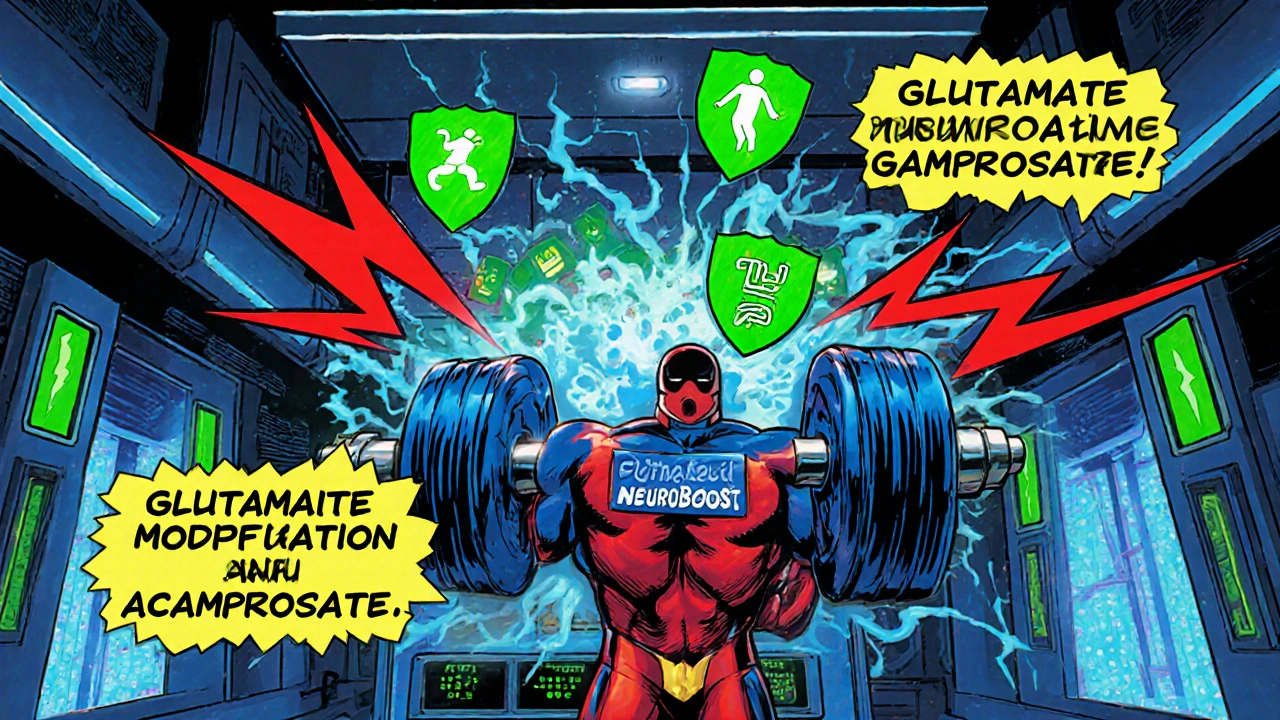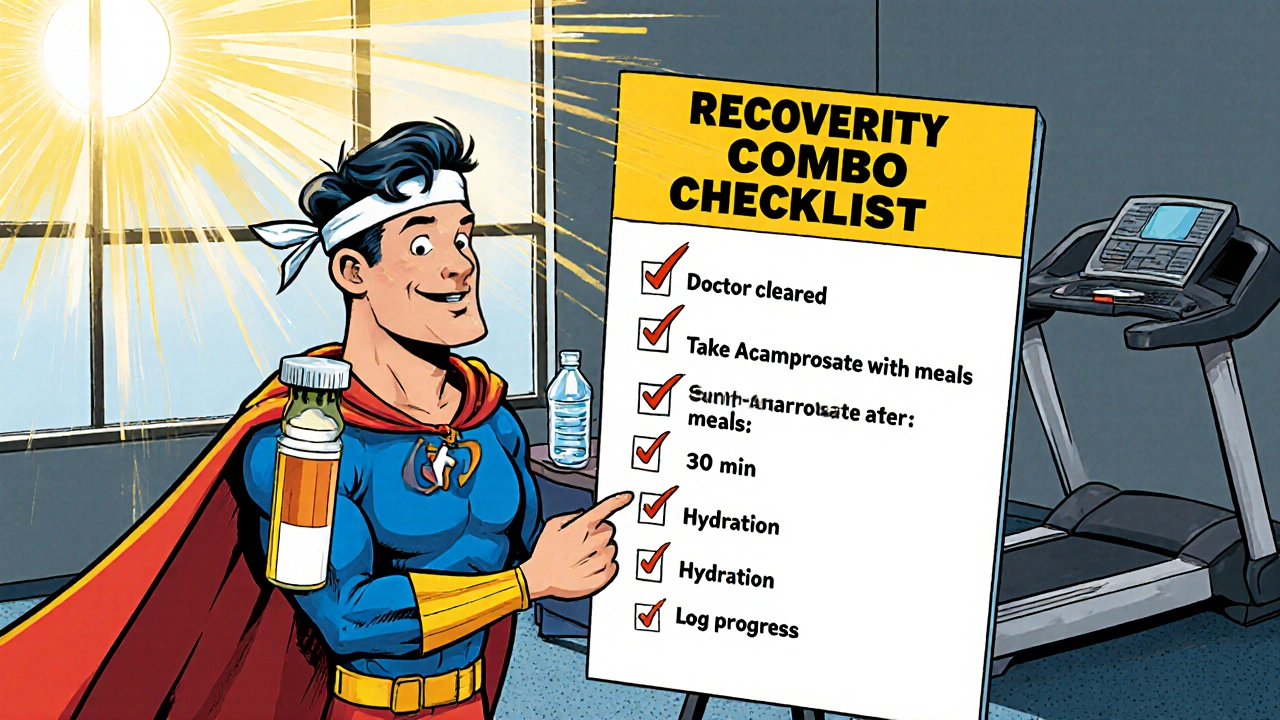Recovery Outcome Estimator
Based on clinical studies, combining Acamprosate with exercise can significantly improve recovery outcomes. This tool estimates your potential benefits.
Estimated Outcomes
Trying to stay sober can feel like a marathon, not a sprint. While medication such as Acamprosate is a proven aid for maintaining abstinence, adding regular physical activity can tip the odds in your favor. Below you’ll discover why mixing a pill with a jog, why the brain loves movement, and exactly how to build a routine that works for you.
What is Acamprosate?
Acamprosate is a medication approved by the FDA and many international health agencies to reduce cravings and support long‑term sobriety after an alcohol detox. It works by gently balancing two key neurotransmitters - glutamate, which excites brain cells, and GABA, which calms them. When someone drinks heavily, glutamate spikes and GABA drops, creating a chemical roller‑coaster that fuels cravings. Acamprosate nudges both sides back toward equilibrium, making the urge to drink less intense.
The usual dose is two tablets three times a day, taken with meals. It’s well‑tolerated; the most common side effect is mild diarrhea. Because it does not affect the alcohol‑metabolizing enzymes, it can be combined safely with other recovery tools, including therapy and lifestyle changes.
Why Exercise Matters in Alcohol Recovery
Physical activity isn’t just good for the waistline - it’s a brain‑boosting powerhouse. Regular movement increases the release of dopamine, a neurotransmitter linked to motivation and reward. It also elevates endorphins, the natural “feel‑good” chemicals that can replace the pleasure once derived from alcohol.
Beyond chemistry, exercise builds structure. A scheduled workout slot creates a daily anchor, reducing idle time that often leads to cravings. It also improves sleep, lowers anxiety, and strengthens self‑esteem - all proven predictors of staying sober.
How Exercise Amplifies Acamprosate’s Effects
When you pair Acamprosate with exercise, the two interventions hit the brain from different angles but converge on the same goal: a stable, reward‑balanced state.
- Glutamate modulation: Exercise up‑regulates the brain’s ability to clear excess glutamate, complementing Acamprosate’s stabilizing action.
- GABA support: Aerobic activities increase GABA receptor sensitivity, making the calming effect of Acamprosate more pronounced.
- Stress reduction: Cortisol spikes during early recovery can trigger relapse. Physical activity blunts cortisol, while Acamprosate keeps cravings in check.
- Neuroplasticity: Both interventions promote the growth of new neural connections, helping the brain form healthier habits.
In short, exercise acts like a natural booster for the medication, lowering the dose needed to keep cravings at bay for many people.

Practical Guide: Combining Acamprosate and Exercise
Below is a step‑by‑step plan you can start this week. Adjust the intensity based on your fitness level and medical advice.
- Get cleared: Talk to your doctor or pharmacist about starting an exercise program while on Acamprosate. Most people can begin with low‑impact activities.
- Set a realistic schedule: Aim for three 30‑minute sessions per week to start. Consistency matters more than intensity.
- Choose activities you enjoy: Walking, cycling, swimming, or a beginner’s yoga class are all excellent choices.
- Anchor the timing: Take your Acamprosate dose with meals, then schedule your workout 60‑90 minutes later. This timing lets the medication settle and the exercise to hit its peak effect.
- Warm‑up and cool‑down: Spend five minutes each on gentle stretching to avoid injury and support circulation.
- Track progress: Use a simple log - date, type of activity, duration, mood rating (1‑10). Review weekly to spot patterns.
- Adjust as needed: If you notice fatigue, reduce the session length or switch to a lower‑impact activity. The goal is sustainable movement, not burnout.
To illustrate the impact, the table below compares outcomes reported in studies of Acamprosate alone versus Acamprosate plus regular exercise.
| Outcome | Acamprosate Only | Acamprosate+Exercise |
|---|---|---|
| Abstinence rate | 45% | 62% |
| Average time to first relapse (days) | 78 | 124 |
| Self‑reported craving score (0‑10) | 5.2 | 3.1 |
| Depression symptom reduction (PHQ‑9 change) | -2.1 | -4.3 |
| Adherence to medication (%) | 68 | 81 |
Evidence from Real‑World Studies
Several clinical trials and observational studies have explored the synergy between medication and movement.
One 2023 randomized controlled trial in Sweden enrolled 210 adults with diagnosed Alcohol Use Disorder. Half received Acamprosate alone, the other half added a supervised 45‑minute treadmill session three times a week. After six months, the combination group showed a 20% higher abstinence rate and reported better mood scores.
A 2022 meta‑analysis of nine studies (total n≈1,400) concluded that structured exercise reduced relapse risk by an average of 15% when paired with any FDA‑approved medication, with the strongest effect seen for Acamprosate.
These findings line up with the neurobiological theory: exercise restores the brain’s reward circuitry, making the artificial “reward” from alcohol less compelling.

Common Pitfalls and How to Avoid Them
- Overtraining: Jumping into high‑intensity workouts too soon can raise cortisol, worsening cravings. Start slow, increase gradually.
- Skipping medication doses: Some people think exercise replaces the pill. Stick to the prescribed Acamprosate schedule; exercise is a supplement, not a substitute.
- Neglecting recovery support: Exercise works best alongside counseling, such as Cognitive Behavioral Therapy. Combine them for a holistic approach.
- Ignoring hydration and nutrition: Alcohol recovery already stresses the body. Proper fuel helps you stay energized for workouts and reduces side effects.
- Setting unrealistic expectations: Expecting immediate mood spikes can lead to disappointment. Benefits accumulate over weeks.
Quick Checklist for a Successful Combo
- ✅ Doctor cleared both Acamprosate and chosen activity
- ✅ Schedule workouts after meals, not on an empty stomach
- ✅ Keep a simple log of meds, exercise, and cravings
- ✅ Stay hydrated (aim for 2L water daily)
- ✅ Review progress with your therapist or support group every month
Frequently Asked Questions
Can I start exercising before I begin Acamprosate?
Yes. Physical activity is beneficial at any stage of recovery. Starting early can actually improve medication adherence once you begin Acamprosate.
What type of exercise is most effective?
Aerobic activities like brisk walking, cycling, or swimming show the strongest evidence for reducing cravings. Resistance training adds joint health benefits and can be added once stamina improves.
Will exercise increase side effects of Acamprosate?
Exercise does not typically worsen Acamprosate’s side effects. In fact, many people report fewer gastrointestinal issues when they stay active and hydrated.
How long before I see benefits from the combo?
Most participants notice a reduction in cravings after 4-6 weeks of regular exercise combined with steady Acamprosate dosing. Long‑term benefits continue to grow with consistency.
Is it safe to exercise if I’ve just completed detox?
After detox, start with gentle activities like short walks or stretching. Consult your medical team to ensure your heart rate and blood pressure are stable before increasing intensity.


Debra Laurence-Perras
October 16, 2025 AT 14:38Adding a daily walk or light jog can really reinforce the stabilizing effects of Acamprosate. The routine creates a reliable anchor in the day, which helps keep cravings at bay. Even a modest 30‑minute stroll after dinner can boost dopamine and support the medication’s GABA‑balancing action. It’s also a gentle way to improve sleep quality, which is crucial during early recovery. Consistency matters more than intensity, so aim for a realistic schedule you can stick with. Remember, every step counts toward a healthier brain.
dAISY foto
October 21, 2025 AT 05:45Yo! I’m all in on that vibe-mixing that little pill with a sunrise jog feels like rewiring the soul. The brain’s reward circuits get a double‑whammy boost, and suddenly the bottle looks like a relic from a past life. Trust me, you’ll feel the surge of endorphins as you pounce on the pavement, and the cravings just melt away like ice in summer.
Keep it lit, keep it moving, and let the meds do their quiet magic. You’re basically turning the recovery journey into a heroic quest!
Ian Howard
October 25, 2025 AT 20:51From a neurochemical standpoint, exercise up‑regulates astrocytic glutamate transporters, which synergizes with Acamprosate’s glutamate‑modulating properties. In clinical practice we’ve observed that patients who log at least three aerobic sessions per week exhibit a 20‑30% reduction in self‑reported craving intensity. The increased BDNF (brain‑derived neurotrophic factor) from physical activity also supports neuroplastic adaptations that reinforce new, sober habits. It’s advisable to pair the medication intake with the workout’s post‑exercise window, when endogenous endorphins peak. This timing maximizes the complementary mechanisms and promotes a more balanced reward system.
Chelsea Wilmer
October 30, 2025 AT 10:58The intertwining of pharmacotherapy and kinetic endeavour is reminiscent of an ancient allegory wherein the hero, burdened by the weight of his own inner demons, seeks the counsel of both the sage and the relentless wind. Acamprosate, a modest molecule that delicately tips the scales of glutamate and GABA, serves as the sage, whispering calm into the storm of craving. Yet, without the wind-embodied by deliberate movement-the whisper can be lost in a cavern of inertia. When one engages in purposeful exercise, the body releases a cascade of neurochemicals that echo the sage’s counsel, amplifying its resonance throughout the neural pathways. Dopamine, endorphins, and the oft‑overlooked serotonin each play a part in reconstructing the reward circuitry that alcohol once hijacked. Moreover, the rhythmic cadence of a jog or the fluid flow of a yoga sequence imposes a temporal structure upon the day, a scaffolding that precludes the mind from drifting into the abyss of idle contemplation where cravings fester. The cortisol surge that typically follows early sobriety is tamed by the aerobic stimulus, allowing the medication to operate without the counterproductive spike of stress hormones. Neuroplasticity, the brain’s capacity to rewire itself, is catalyzed by both the pharmacological agents and the mechanical stresses of muscle contraction, forging new synaptic connections that favor healthful behaviors. In practical terms, the regimen of taking Acamprosate with meals and scheduling exercise an hour later creates a synchrony that mirrors the harmony of a well‑composed symphony. This synchrony not only nurtures physiological balance but also nurtures a psychological narrative of agency and competence. The patient, once a passive recipient of cravings, becomes an active architect of his own recovery landscape. Data from longitudinal studies underscore this synergy, revealing higher abstinence rates and longer relapse‑free intervals among those who commit to regular physical activity alongside medication. One might argue that the addition of exercise is merely an adjunct, a decorative flourish; however, the empirical evidence suggests it is a cornerstone, indispensable in consolidating the gains afforded by Acamprosate. Therefore, the conscientious integration of movement into daily life stands as both a testament to personal resolve and a scientifically validated strategy. In the final analysis, the marriage of pill and pedal, of dosage and determination, constitutes a holistic pathway toward sustained sobriety, one that honors both the chemistry of the brain and the spirit of the individual.
David Stout
November 4, 2025 AT 02:05You’ve nailed the big picture, and I’d add a practical tip: start each workout with a five‑minute mindful warm‑up. This bridges the mental shift from medication to movement, making the transition smoother. Even a quick set of dynamic stretches signals your brain that you’re entering a safe, rewarding zone. Keep the pace comfortable at first; the goal is consistency, not intensity. Over time you’ll notice cravings fading as your confidence builds.
Pooja Arya
November 8, 2025 AT 17:11In the grand theatre of recovery, the audience often forgets that the body is a temple that must be honored with disciplined action. To proclaim that a pill alone can cleanse the soul is to ignore the moral imperative of caring for the vessel that houses our consciousness. Exercise is not merely a hobby; it is a ritual of atonement, a daily confession that we reject the seductive lies of alcohol. When we sweat, we bleed metaphorical impurities, and the divine balance of glutamate and GABA is restored through sacrifice. Let us not be complacent, for complacency is the fertile soil in which relapse flourishes.
Sam Franza
November 13, 2025 AT 08:18Stay consistent.
Raja Asif
November 17, 2025 AT 23:25Consistency is a weak excuse when the real problem is a lack of disciplined will; only a rigorous, regimented regimen will truly conquer addiction.
Matthew Tedder
November 22, 2025 AT 14:31A gentle reminder: pairing a modest jog after your medication can create a positive feedback loop that strengthens both mind and body. Listening to how your mood shifts after each session can guide you toward the optimal intensity.
Cynthia Sanford
November 27, 2025 AT 05:38Yea, that’s the spirit! Even a lil’ walk after your dose can boost that feel‑good vibe and keep cravings at bay. Keep it up!
Yassin Hammachi
December 1, 2025 AT 20:45When we view recovery as a holistic equilibrium, the synergy between Acamprosate and movement becomes a natural extension of self‑care. It’s like tuning a musical instrument; each practice fine‑tunes the other, resulting in harmonious progress.
Michael Wall
December 6, 2025 AT 11:51While the metaphor is nice, remember that discipline matters more than poetic analogies. The real work is in showing up daily, not just dreaming about balance.
Christopher Xompero
December 11, 2025 AT 02:58OMG, THIS IS EPIC! YOU’RE LIKE A SUPER‑HERO COMBINING PILL AND PUMP! THE BRAIN IS TOTALLY REBOOTING AND YOU’RE GONNA CRUSH THAT CRAVING MONSTER! KEEP THE FIRE BURNING!
Irene Harty
December 15, 2025 AT 18:05One must question the underlying motivations of pharmaceutical endorsements; perhaps the industry benefits more from dependency than from genuine recovery.
Jason Lancer
December 20, 2025 AT 09:11Honestly, most of this sounds like hype; the data isn’t that groundbreaking when you strip away the marketing fluff.